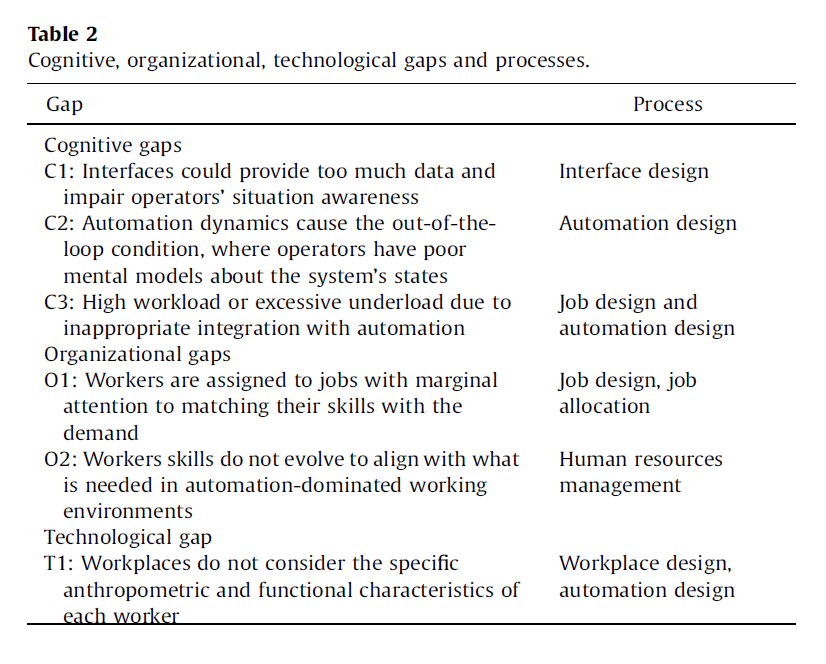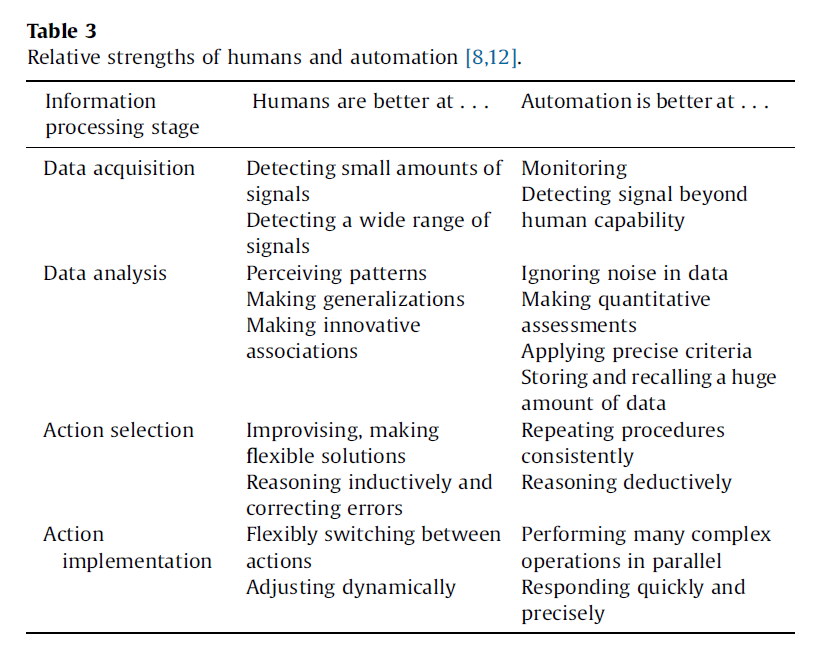(1) 8
Adaptive automation and human factors in manufacturing: An
experimental assessment for a cognitive approach
A B S T R A C T
Despite increasing automation levels and digital solutions, production systems still very much rely on the
inescapable contribution of the human factor. The changing relationship between man, the technological
system and the organization framework together with the increased complexity result in high risks for
workers’ safety and their psychophysical health. Adaptive factory automation and management solutions
integrating the man in the loop are proposed in order to achieve production performance, workers safety
and well being in a balanced way in varying boundary and exogenous conditions. Particularly, this paper
presents new methods and the related recent case studies in different sectors
1. Introduction
While automation in manufacturing dates back to the
first
industrial revolution, the increasing manufacturing systems’
complexity and technology advancements require nowadays
reliable tools to plan, assess, and drive the production chain in
order to get the planned goals. Many methodologies have been
developed to face the organisational aspects by considering the
production plant capacity, customer demand and products
characteristics
At the level of production shop-floor, the
growing
flexibility of production means calls for automation
systems whose behaviour is driven by dynamically adapting
management policies
In the last
fifty years automation evolved
dramatically along several generations: from the direct involve-
ment of workers in the manufacturing process, to intelligent
automation systems where workers play a supervisor role
Indeed, the introduction of new technologies impacts on the
complexity of manufacturing system management and requires to
promote harmonisation between automation and the human
factors
especially considering the cognitive workload related to
manufacturing operations at different decisional levels
This paper proposes a methodology, validated in two selected
industrial cases, to integrate cognitive workload into the design of
workplaces to match the human safety and well-being necessities
and tasks’ cognitive requirements. Specifically, a new framework to classify the fabrication tasks of production processes according to
their cognitive complexity and the required capacity enables an
anthropocentric optimisation of the manufacturing activities
2. Automation and human factors
2.1. Interaction challenges
Human factors and human performance limitations, resulting
in errors and violations, are the main contributors to accidents and
injuries in complex systems
A common approach aimed at
reducing this incidence has been to transfer to automation a
variable portion of the tasks that were previously performed by the
human operator
The shared responsibility between human and automation
could be broadly located along a continuum, as represented in
Table 1
Notwithstanding the successful integration, many issues
occur when considering the relationship between humans and
automation; the problems are essentially:
Out-of-the-loop condition: the difficulty of operators to have a
clear and complete picture of the automation states and
processes, lead to a diminished ability to detect possible
automation failures and to regain manual control
Surprising mode transitions: operators may become unaware of
changes in the operating mode performed by automation
Skill loss: pervasive automation will decrease the opportunity for
training manual skills, which will be ineffective in case of an
urgent manual control of the system
Table 1
The continuum of shared responsibility between human and automation, adapted
from
Automation-induced errors: while automation may compensate
or reduce some typical human errors (counting, remembering,
monitoring, etc.), more automation could lead to new, unex-
pected forms of human errors
Behavioural adaptation: automation may grow the perception of
safety and operators could adapt their behaviour taking higher
risks
Inappropriate trust: trust in automation could change according to
the perception of its reliability. When this perception is biased,
inappropriate trust will result as misuse, disuse and complacency
Job satisfaction: automation could be perceived as a threat to
workers professional profile, especially when it is introduced
without a proper transition and a management care for reskilling
their workers
In order to face the described issues, a comprehensive approach
to map them and an effective strategy at different and relevant
levels, is required. The identification of the intervention areas and
gaps is a crucial step to build a coherent system capable to
harmonize the automated components with their human counterpart.
In current efficiency-driven contexts the cognitive level,
that acts as the interface between human and automation, is
responsible for the workload impacting the worker. Much of this
impact is determined by the decisions taken in the design of the
automation processes as well as by the organizational strategies;
therefore, the organization level must be included in the analysis.
Table 2 shows the gaps and the involved processes for the
cognitive, organizational and technological levels
Table 2
Cognitive, organizational, technological gaps and processes
2.2. Design guidelines
Traditional approaches to enhance the human-automation
interaction are based on the Fitts list
reported in Table 3 Such a
list allocates functions considering the information processing
stage and static conditions. A more effective approach should
assign the functions according to the task, the operator, and the
situation considering the system dynamics: adaptable automation
allows the operator to decide the level of control according to the list reported in Table 1. Adaptive automation can change the
control level by automatically adjusting itself to the operator’s
performance, operator’s state and the system status
Table 3
Relative strengths of humans and automation
The drawbacks of adaptive automation regard the task of
continuously monitoring the operators’ state and environment by
using sensors. In addition, adaptive automation should be able to
quickly change the automation level in a timely manner taking into
account unpredictable operators responses. Furthermore, operators
may abuse or misuse the adaptive automation for personal
advantage, e.g. by slowing down the production pace
Finally, if the adaptation pattern is not perfect, the operators
may not understand it and could think the automation is
performing erratically, thus increasing the likelihood of new
forms of errors
Solutions to minimise these drawbacks depend on the effective
implementation of interfaces to support the operators’ mental
models of the system’s state. Multimodal feedback could help the
operator to gain awareness about the system, by means of multiple
sensory cues such as haptic, peripheral visual, auditory, and tactile.
Another solution is to design automation that can
fit operators’
mental models, instead of forcing them to change their expecta-
tions to the new operational modes. When automation involves
networks of operators interacting with complex systems in a
tightly coupled manner, small events may cause huge effects, due
to the reverberation of signals along the network


